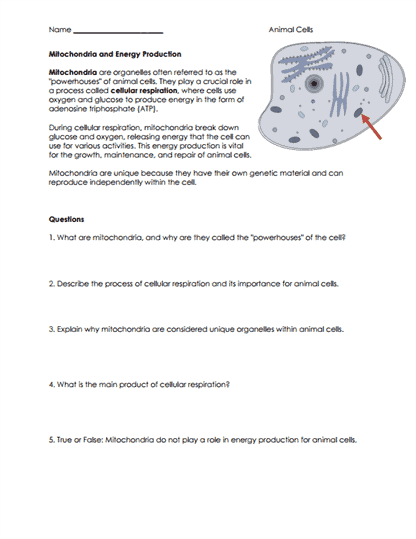Mitochondria and Energy Production

Worksheet Description
The worksheet is dedicated to mitochondria, often labeled the “powerhouses” of animal cells due to their critical role in energy synthesis. It elaborates on how these organelles participate in cellular respiration, a process wherein glucose and oxygen are transformed into adenosine triphosphate (ATP), the cell’s primary energy currency. Accompanied by a detailed diagram, the content explores the uniqueness of mitochondria, highlighting their distinct genetic material and capability to reproduce autonomously within the cell. The questions provided at the end seek to evaluate students’ comprehension of the topic.
For a productive engagement with this worksheet, students should first immerse themselves in the textual content, focusing on the primary functions and attributes of mitochondria. The accompanying illustration offers a visual reinforcement, aiding in the understanding of the mitochondria’s position and structure in an animal cell. Once the core material is well-understood, students can proceed to the questions, using their grasp on the topic to formulate answers. For thoroughness, it’s beneficial to cross-check responses with the primary content, ensuring clarity and accuracy.
This educational material aims to deepen students’ understanding of mitochondria, emphasizing their indispensable role in energy production within animal cells. By elucidating the process of cellular respiration, the worksheet showcases how mitochondria efficiently convert glucose and oxygen into energy, underscoring its importance for cell growth, repair, and overall functionality. The content further highlights the singular characteristics of mitochondria, like housing their distinct genetic matter and independent reproduction capabilities. Through this focus, students are encouraged to recognize the significance of mitochondria in the broader context of cellular biology and animal physiology.
